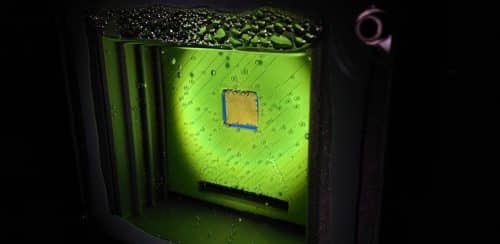Gas that is used a lot, and is produced from fossil fuels, can be prepared today by an 'artificial leaf' that uses only sunlight, carbon dioxide and water, a system that could one day be used in the development of a sustainable liquid fuel that will be an alternative to gasoline

[Translation by Dr. Nachmani Moshe]
Researchers from the University of Cambridge have shown that it is possible to directly produce synthesis gas (syngas, a gas mixture of hydrogen and carbon monoxide) in a sustainable and simple way. Instead of being powered by fossil fuel, an artificial leaf can operate using only the sun's rays. And unlike existing industrial processes for the production of syngas, the leaf does not emit an additional amount of carbon dioxide into the free air. The findings have long been published in the scientific journal Nature Materials.
Today, syngas consists of a mixture of hydrogen and carbon monoxide, and is used in the production of a variety of consumer products, such as fuel, pharmaceuticals, plastic products and fertilizers. "Maybe we haven't heard of Synges himself, but we all consume products made with it. The ability to produce this raw material in a sustainable manner will be an essential step in closing the global carbon cycle while promoting the fuel and sustainable chemicals industry," said one of the researchers.
The system created by the researchers was inspired by the mechanism of photosynthesis - the natural process by which plants use the energy from the sun's rays to convert carbon dioxide into food. On top of the artificial leaf are two light receptors similar to molecules found in plants and responsible for harnessing sunlight, together with a catalyst consisting of the metallic element common in nature, cobalt. When the device is immersed in water, one of the light absorbing components uses a catalyst to produce oxygen. The second light absorbing component is responsible for the chemical reaction that converts carbon dioxide and water into carbon monoxide and hydrogen, producing the syngas mixture. As a bonus, the researchers discovered that the light-absorbing components used are also active in low levels of sunlight, for example on rainy and cloudy days. "The meaning is that you are not limited to using this technology only in warm and sunny countries, or in the spring and summer seasons, and in fact the technology will be able to be active from dawn to dusk."
Other artificial leaves have also been developed, but these generally produce only hydrogen. The researchers explain that the reason why they were able to produce their syngas sustainably is the combination of the specific materials and catalysts they chose. Among these materials are scientifically advanced light receptors based on the mineral perovskite, which provide high photovolts and electric current that enable the existence of the reaction thanks to which carbon dioxide is converted to carbon monoxide, compared to light receptors based on silicon or other coloring materials. In addition, the researchers used cobalt metal as the catalyst in the system, instead of the much more expensive platinum or silver metals. Not only is cobalt cheap, but it is more efficient at producing carbon monoxide than other catalysts. Now, the research team is exploring ways to utilize its technology to produce a sustainable liquid fuel alternative to gasoline. Already today syngas is used as a raw material for the production of liquid fuel. "What we would like to do in the next step, instead of first producing syngas and then converting it to fuel, is to create the liquid fuel in one step from carbon monoxide and water," explains the lead researcher.
Despite the great advances made so far in the production of electricity from renewable energy sources, such as wind and photovoltaic devices, the main researcher explains that the development of synthetic fuel is an existing need, this is in light of the fact that electricity currently only provides about a quarter of the global demand for energy. "There is a great need for liquid fuel in order to operate heavy transport vehicles, ships and planes, all in a sustainable manner. We intend to produce sustainable and important products, such as ethanol, which can easily be used to create fuel," explains the researcher. "It is challenging to produce syngas in a single step from sunlight using a reaction that converts carbon dioxide. However, we are sure that we are moving in the right direction, and that we have the right catalyst, so we believe that we will be able to create a device that can demonstrate this process in the near future."

2 תגובות
Don't you know your own socks?
"Today, syngas consists of a mixture of hydrogen and carbon monoxide" - and what was it composed of yesterday?